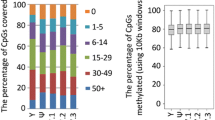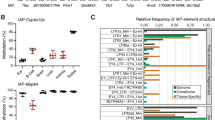Abstract
The methylation status of a transgene, which carried the adenovirus type 2 E2A late promoter linked to the chloramphenicol acetyltransferase gene, was studied in three transgenic mouse lines (5–8, 7–1 and 8–1). These lines were analysed over a large number of offspring generations beyond the founder animal. In mating experiments, the influence of the parent-of-origin and strain-specific backgrounds on the transgene methylation patterns were assessed and found to have no effect on the pre-established methylation patterns in mouse lines 5–8 and 8–1. The founder animal 7–1 carried two groups of a total of ten transgenes, which were located on two different chromosomes. These arrays of transgenes could be segregated into separate mouse lines 7-1A and 7-1B. The transgenes of 7-1A animals exhibited cellular mosaic methylation, patterns that were demethylated in approximately 10% of the offspring in a mixed genetic background. Upon further transmission of these transgenes in a mixed genetic background, the grandparental methylation patterns were reestablished in most progeny. Mating to inbred DBA/2 mice resulted in maintenance of the demethylated pattern or in further demethylation of the transgenes in approximately 50% of the offspring. In contrast, an equal number of transgenic siblings from matings to C57BL/6 mice showed a return to the original methylation pattern. The mosaic methylation status of this locus was apparently controlled by mouse-strain-specific factors. The methylation patterns of the 7-1B transgenes were not cellular mosaic and remained stable in all offspring, as with lines 5–8 and 8–1. Hence, the strain-dependent and cellular mosaic transgene methylation patterns of 7-1A animals were probably a consequence of the chromosomal integration site of the transgenes (position effect).
Similar content being viewed by others
References
Allen, N.D. and Mooslehner, K. (1992) Imprinting, transgene methylation and genotype specific modification.Semin. Dev. Biol. 3, 87–98.
Allen, N.D., Norris, M.L. and Surani, M.a. (1990) Epigenetic control of transgenic expression and imprinting by genotypespecific modifiers.Cell 61, 853–61.
Ariel, M., Cedar, H. and McCarrey, J. (1994) Developmental changes in methylation of spermatogenesis-specific genes includes reprogramming in the epididymus.Nature Genetics 7, 59–63.
Beechey, C.V. and Cattanach, B.M. (1993) Genetic imprinting map.Mouse Genome 91, 102–4.
Brandeis, M.J., Kafri, T., Ariel, M., Chaillet, J.R., McCarrey, J., Razin, A. and Cedar, H. (1993) The ontogeny of allelespecific methylation associated with imprinted genes in the mouse.EMBO J. 12, 366–3677.
Chaillet, J.R. (1992) DNA methylation and genomic imprinting in the mouse.Semin. Dev. Biol. 3, 99–105.
Chaillet, J.R., Vogt, T.F., Beier, D.R. and Leder, P. (1991) Parental specific methylation is established during gametogenesis and progressively changes during embryogenesis.Cell 66, 77–83.
Doerfler, W. (1983) DNA methylation and gene activity.Annu. Rev. Biochem. 52, 93–124.
Doerfler, W. (1993) Adenoviral DNA integration and changes in DNA methylation patterns: a different view of insertional mutagenesis.Progr. Nucl. Acid. Res. Mol. Biol. 46, 1–36.
Engler, P., Haasch, D., Pinkert, C.A., Doglio, L., Glymour, M., Brinster, R. and Storb, U. (1991) A strain-specific modifier on mouse chromosome 4 controls the methylation of independent transgene loci.Cell 65, 939–47.
Groudine, M. and Conkin, K.F. (1985) Chromatin structure andde novo methylation of sperm DNA: implications for activation of the paternal genome.Science 228, 1061–8.
Hadchouel, M., Farza, H., Simon, D., Tiollais, P. and Pourcel, C. (1987) Maternal inhibition of hepatitis B surface antigen gene expression in transgenic mice correlates withde novo methylation.Nature 329, 454–6.
Heller, H., Kämmer, C., Wilgenbus, P. and Doerfler, W. (1995) The chromosomal insertion of foreign (adenovirus type 12, plasmid or bacteriophage lambda) DNA is associated with enhanced methylation of cellular DNA segments.Proc. Natl Acad. Sci. USA 92, 5515–9.
Kafri, T., Ariel, M., Brandeis, M., Shemer, R., Urven, L., McCarrey, J., Cedar, H. and Razin, A. (1992) Developmental pattern of gene-specific DNA methylation in the mouse embryo and germ line.Genes Dev. 6, 705–14.
Koetsier, P.A., Schorr, J. and Doerfler, W. (1993) A rapid optimized protocol for downward alkaline blotting of DNA.Bio Techniques 15, 260–2.
Kothary, R., Barton, S.C., Franz, T., Norris, M.L., Hettle, S. and Surani, M.A.H. (1991) Unusual cell specific expression of a human cytomegalovirus immediate early gene promoter-lacZ hybrid gene in transgenic mouse embryos.Mech. Dev. 35, 25–31.
Langner, K.D., Weyer, U. and Doerfler, W. (1986)Trans effect of the El region of adenoviruses on the expression of the procaryotic gene in mammalian cells: resistance to 5′-CCGG-3′ methylation.Proc. Natl Acad. Sci. USA 83, 1598–602.
Lettmann, C., Schmitz, B. and Doerfler, W. (1991) Persistence or loss of preimposed methylation patterns andde novo methylation of foreign DNA integrated in transgenic mice.Nucl. Acids Res. 19, 7131–7.
Lichter P. and Cremer, T. (1992) Chromosome analysis by nonisotopicin situ hybridization. In Rooney, D. E. and Czepulkowski, B. H. eds.,Human Cytogenetics: a Practical Approach. Vol. 1, pp. 157–192. Oxford: IRL Press at Oxford University Press.
McGowan, R., Campbell, R., Peterson, A. and Sapienza, C. (1989) Cellular mosaicism in the methylation and expression of hemizygous loci in the mouse.Genes Dev. 3, 1669–76.
Müller, U. and Doerfler, W. (1987) Fixation of the unmethylated or the 5′-CCGG-3′ methylated adenovirus late promoter-cat gene construct in the genome of hamster cells: gene expression and stability of methylation patterns.J. Virol. 61, 3710–20.
Reik, W., Collick, A., Norris, M.L., Barton, S.C. and Surani, M.A. (1987) Genomic imprinting determines methylation of parental alleles in transgenic mice.Nature 328, 248–51.
Reik, W., Howlett, S.K. and Surani, M.A. (1990) Imprinting by DNA methylation: from transgenes to endogenous sequences.Development 1990 Supplement, 99–106.
Sapienza, C., Peterson, A.C., Rossant, J. and Balling, R. (1987) Degree of methylation on gamete of origin is dependent on gamete of origin.Nature 328, 251–4.
Sapienza, C., Paquette, J., Tran, T.H. and Peterson, A.C. (1989) Epigenetic and genetic factors affect transgene methylation imprinting.Development 107, 165–8.
Sasaki, H., Hamada, H., Ueda, T., Seki, R., Higashinakagawa, T. and Sakaki, Y. (1991) Inherited type of allelic methylation variations in a mouse chromosome region where an integrated transgene shows transgene imprinting.Development 111, 573–81.
Sasaki, H., Allen, N.D. and Surani, M.A. (1993) DNA methylation and genomic imprinting in mammals. In Jost, J. P. and Saluz, H. P., eds.,DNA Methylation: Molecular Biology and Biological Significance, pp. 469–486. Basel: Birkhäuser Verlag.
Southern, E.M. (1975) Detection of specific sequences among DNA fragments separated by gel electrophoresis.J. Mol. Biol.98, 503–17.
Stöger, R., Kubicka, P., Liu, C.-G., Kafri, T., Razin, A., Cedar, H. and Barlow, D.P. (1993) Maternal-specific methylation of the imprinting mouseIgf2r locus identifies the expressed locus as carrying the imprinted signal.Cell 73, 61–71.
Surani, M.A., Kothary, R., Allen, N.D., Singer, P.B., Fundele, R., Ferguson-Smith, A.C. and Barton, S.C. (1990) Genomic imprinting and development in mouse.Development 1990 Supplement, 89–98.
Swain, J.L., Stewart, T.A. and Leder, P. (1987) parental legacy determines methylation and expression of an autosomal transgene: a molecular mechanism for parental imprinting.Cell 50, 719–27.
Toth, M., Lichtenberg, U. and Doerfler, W. (1989) Genomic sequencing reveals a 5-methylcytosine free domain in active promoters and the spreading of preimposed methylation patterns.Proc. Natl Acad. Sci USA 86, 3728–32.
Toth, M., Müller, U. and Doerfler, W. (1990) Establishment ofde novo methylation patterns. Transcription factor binding and deoxyctidine methylation at CpG and non-CpG sequences in an integrated adenovirus promotor.J. Mol. Biol. 214, 673–83.
Ueda, T., Yamazaki, K., Suzuki, R., Fujimoto, H., Sasaki, H., Sakaki, Y. and Higashinakagawa, T. (1992) Parental methylation patterns of a transgenic locus in adult somatic tissues are imprinted during gametogenesis.Development 116, 831–9.
Author information
Authors and Affiliations
Rights and permissions
About this article
Cite this article
Koetsier, P.A., Mangel, L., Schmitz, B. et al. Stability of transgene methylation patterns in mice: Position effects, strain specificity and cellular mosaicism. Transgenic Research 5, 235–244 (1996). https://doi.org/10.1007/BF01972877
Received:
Revised:
Accepted:
Issue Date:
DOI: https://doi.org/10.1007/BF01972877




